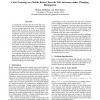Free Online Productivity Tools
i2Speak
i2Symbol
i2OCR
iTex2Img
iWeb2Print
iWeb2Shot
i2Type
iPdf2Split
iPdf2Merge
i2Bopomofo
i2Arabic
i2Style
i2Image
i2PDF
iLatex2Rtf
Sci2ools
121
Voted
IJCAI
2007
2007
Color Learning on a Mobile Robot: Towards Full Autonomy under Changing Illumination
A central goal of robotics and AI is to be able to deploy an agent to act autonomously in the real world over an extended period of time. It is commonly asserted that in order to do so, the agent must be able to learn to deal with unexpected environmental conditions. However an ability to learn is not sufficient. For true extended autonomy, an agent must also be able to recognize when to abandon its current model in favor of learning a new one; and how to learn in its current situation. This paper presents a fully implemented example of such autonomy in the context of color map learning on a vision-based mobile robot for the purpose of image segmentation. Past research established the ability of a robot to learn a color map in a single fixed lighting condition when manually given a “curriculum,” an action sequence designed to facilitate learning. This paper introduces algorithms that enable a robot to i) devise its own curriculum; and ii) recognize when the lighting conditions h...
| Added | 29 Oct 2010 |
| Updated | 29 Oct 2010 |
| Type | Conference |
| Year | 2007 |
| Where | IJCAI |
| Authors | Mohan Sridharan, Peter Stone |
Comments (0)

